
|
Now it is 11.2 mag (Mar. 20, Juan Jose Gonzalez). It stays bright as 11 mag for a long time. In the Southern Hemisphere, it is not observable for a long time after this. In the Northern Hemispehre, it stays observable for a long time until the comet fades out. But it will be getting lower gradually after this.
Date(TT) R.A. (2000) Decl. Delta r Elong. m1 Best Time(A, h)
Apr. 7 4 37.00 38 38.6 3.017 2.625 57 10.9 19:52 (114, 40)
Apr. 14 4 46.94 40 5.9 3.081 2.617 53 11.0 19:59 (118, 36)
|
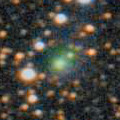
|
Now it is bright as 11.3 mag (Mar. 24, Marco Goiato). It is expected to brighten up to 9 mag in summer. In the Southern Hemisphere, it stays observable in good condition for a long time until the comet will fade out. In the Northern Hemisphere, it is observable only until June.
Date(TT) R.A. (2000) Decl. Delta r Elong. m1 Best Time(A, h)
Apr. 7 19 37.91 -3 42.1 2.583 2.630 81 11.3 4:12 (311, 38)
Apr. 14 19 40.44 -5 1.8 2.426 2.589 87 11.1 4:01 (315, 39)
|
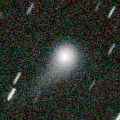
|
Now it is 12.0 mag (Mar. 20, Juan Jose Gonzalez). It stays 12 mag for a long time until spring in 2019. In the Northern Hemisphere, it stays observable in good condition for a long time, although it becomes unobservable temporarily from mid June to August. In the Southern Hemisphere, it is not observable until September.
Date(TT) R.A. (2000) Decl. Delta r Elong. m1 Best Time(A, h)
Apr. 7 8 14.83 71 17.5 2.705 2.875 89 12.1 19:52 (175, 54)
Apr. 14 8 0.12 67 36.1 2.764 2.849 84 12.1 19:59 (165, 55)
|
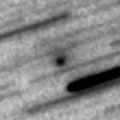
|
Now it is 17.0 mag (Mar. 25, B. Lutkenhoner). It will brighten rapidly after this, and will brighten up to 12 mag from April to June. In the Southern Hemisphere, it stays observable in excellent condition. In the Northern Hemisphere, it will be unobservable from April to June when the comet becomes brightest.
Date(TT) R.A. (2000) Decl. Delta r Elong. m1 Best Time(A, h)
Apr. 7 19 32.08 -39 2.2 1.016 1.407 88 13.2 4:12 (333, 9)
Apr. 14 20 9.91 -39 48.6 0.974 1.373 87 12.8 4:01 (330, 7)
|
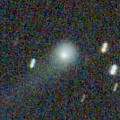
|
Now it is very bright as 12.8 mag (Mar. 12, Seiichi Yoshida). It will be observable at 12-13 mag for a long time from 2017 to 2018. In the Southern Hemisphere, it will be hardly observable after this.
Date(TT) R.A. (2000) Decl. Delta r Elong. m1 Best Time(A, h)
Apr. 7 15 17.92 52 50.4 3.234 3.753 113 12.9 2:19 (180, 72)
Apr. 14 14 56.39 54 39.1 3.247 3.760 113 12.9 1:30 (180, 70)
|

|
The condition of this apparition is worst. It brightens up to 12.5 mag from April to May. But it is not observable at all.
Date(TT) R.A. (2000) Decl. Delta r Elong. m1 Best Time(A, h)
Apr. 7 0 2.01 1 47.7 1.651 0.740 15 14.3 4:12 (261, -9)
Apr. 14 0 42.97 4 49.8 1.622 0.674 11 13.4 4:01 (255,-12)
|

|
Appearing in the morning sky. Now it is a bit brighter, 15.7 mag (Apr. 3, Jean-Francois Soulier).
Date(TT) R.A. (2000) Decl. Delta r Elong. m1 Best Time(A, h)
Apr. 7 22 46.34 -4 15.6 6.572 5.788 35 13.8 4:12 (277, 3)
Apr. 14 22 50.92 -3 40.9 6.504 5.787 41 13.8 4:01 (278, 6)
|
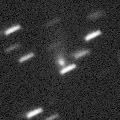
|
Now it is 15.1 mag (Mar. 16, Kunihiro Shima). It will brighten up to 9 mag in summer. However, it is hardly observable when it is bright. In the Northern Hemisphere, it will be unobservable soon. Then it is not observable until late December. In the Southern Hemisphere, it is observable from July to September, but it locates in extremely low.
Date(TT) R.A. (2000) Decl. Delta r Elong. m1 Best Time(A, h)
Apr. 7 1 44.95 33 59.0 2.742 1.930 29 14.0 19:52 (127, 7)
Apr. 14 1 59.35 32 41.7 2.701 1.837 24 13.8 19:59 (129, 3)
|
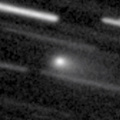
|
Now it is 15.4 mag (Apr. 3, Jean-Francois Soulier). It will be observable at 14 mag in good condition from spring to summer.
Date(TT) R.A. (2000) Decl. Delta r Elong. m1 Best Time(A, h)
Apr. 7 20 35.47 -25 18.3 1.632 1.632 72 14.3 4:12 (314, 13)
Apr. 14 20 55.58 -23 44.8 1.578 1.623 74 14.2 4:01 (312, 14)
|
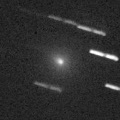
|
It brightened up to 11 mag in February. Now it is fading. It has already faded down to 14.5 mag (Apr. 5, Martin Masek). It stays observable in the evening sky until the comet fades out.
Date(TT) R.A. (2000) Decl. Delta r Elong. m1 Best Time(A, h)
Apr. 7 4 49.12 11 1.2 1.622 1.350 56 14.4 19:52 ( 82, 30)
Apr. 14 5 15.94 11 33.5 1.706 1.415 56 15.0 19:59 ( 84, 29)
|

|
It brightened up to 7.1 mag from May to June in 2017 (June 21, Juan Jose Gonzalez). Now it is fading. It has already faded down to 15.2 mag (Mar. 4, B. Lutkenhoner). In the Southern Hemisphere, it stays observable for a long time after this. It will never be observable again in the Northern Hemisphere.
Date(TT) R.A. (2000) Decl. Delta r Elong. m1 Best Time(A, h)
Apr. 7 0 23.76 -44 8.7 4.474 3.930 51 14.6 4:12 (303,-35)
Apr. 14 0 34.37 -43 43.8 4.497 3.996 54 14.7 4:01 (303,-34)
|

|
It brightened up to 9.2 mag from November to December (Nov. 16, Juan Jose Gonzalez). Now it is fading rapidly. It has already faded down to 16.5 mag (Mar. 24, Toshihiko Ikemura, Hirohisa Sato). It stays observable in good condition until summer when it fades out.
Date(TT) R.A. (2000) Decl. Delta r Elong. m1 Best Time(A, h)
Apr. 7 14 9.48 5 21.6 1.068 2.036 159 14.9 1:11 ( 0, 60)
Apr. 14 14 1.79 5 33.8 1.104 2.084 162 15.3 0:35 ( 0, 60)
|
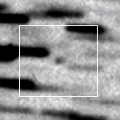
|
Now it is 17.1 mag (Mar. 24, Toshihiko Ikemura, Hirohisa Sato). It will brighten rapidly after this, and it will brighten up to 11 mag from summer to autumn. It is observable in excellent condition in the Southern Hemisphere. It locates somewhat low in the Northern Hemisphere.
Date(TT) R.A. (2000) Decl. Delta r Elong. m1 Best Time(A, h)
Apr. 7 20 20.55 -16 55.5 2.303 2.234 73 15.3 4:12 (311, 22)
Apr. 14 20 33.59 -16 34.7 2.206 2.212 77 15.0 4:01 (312, 22)
|

|
It brightened up to 12.7 mag in winter (Jan. 6, Thomas Lehmann). Now it is fading. It has already faded down to 15.0 mag (Mar. 22, Toshihiko Ikemura, Hirohisa Sato). It will be getting lower gradually after this in the evening sky. It will be unobservable in May.
Date(TT) R.A. (2000) Decl. Delta r Elong. m1 Best Time(A, h)
Apr. 7 3 58.01 10 57.0 2.916 2.297 43 15.0 19:52 ( 90, 20)
Apr. 14 4 9.00 13 20.1 3.021 2.339 39 15.1 19:59 ( 96, 16)
|
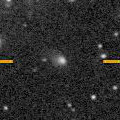
|
Now it is 15.7 mag (Mar. 16, Toshihiko Ikemura, Hirohisa Sato). It is expected to brighten up to 13-14 mag from 2018 to 2019. In the Northern Hemisphere, it stays observable in good condition for a long time. In the Southern Hemisphere, it locates extremely low until summer.
Date(TT) R.A. (2000) Decl. Delta r Elong. m1 Best Time(A, h)
Apr. 7 19 37.96 42 10.1 4.281 4.205 78 15.4 4:12 (245, 61)
Apr. 14 19 35.45 42 55.7 4.179 4.166 82 15.3 4:01 (242, 64)
|

|
Now it is 16.2 mag (Mar. 17, S. G. McAndrew). It stays 15 mag from 2018 to 2019, and it will be observable for a long time in the Southern Hemisphere. In the Northern Hemisphere, it will never be observable again.
Date(TT) R.A. (2000) Decl. Delta r Elong. m1 Best Time(A, h)
Apr. 7 13 34.69 -66 16.5 4.111 4.693 120 15.5 0:37 ( 0,-11)
Apr. 14 13 23.07 -67 2.9 4.050 4.662 122 15.4 23:52 ( 0,-12)
|

|
Appearing in the morning sky in the Southern Hemisphere. It is observable at 15 mag in good condition in 2018. It is not observable until May in the Northern Hemisphere.
Date(TT) R.A. (2000) Decl. Delta r Elong. m1 Best Time(A, h)
Apr. 7 22 8.34 -19 19.0 3.577 3.033 50 15.9 4:12 (295, 1)
Apr. 14 22 18.01 -18 40.5 3.514 3.043 54 15.9 4:01 (295, 3)
|
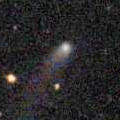
|
Now it is 16.2 mag (Mar. 11, Toshihiko Ikemura, Hirohisa Sato). It stays 16 mag for a long time from 2017 to 2018. It is observable in excellent condition in the Northern Hemisphere. It locates very low in the Southern Hemisphere.
Date(TT) R.A. (2000) Decl. Delta r Elong. m1 Best Time(A, h)
Apr. 7 7 7.65 44 20.2 5.392 5.421 86 15.9 19:52 (123, 68)
Apr. 14 7 6.08 44 30.5 5.521 5.431 79 15.9 19:59 (120, 61)
|
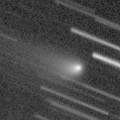
|
Appearing in the morning sky. It is fading now. But it stays 16 mag until summer. But actually, it is 18.1 mag (Mar. 23, Toshihiko Ikemura, Hirohisa Sato), fainter than this ephemeris.
Date(TT) R.A. (2000) Decl. Delta r Elong. m1 Best Time(A, h)
Apr. 7 19 8.22 -23 59.5 3.364 3.532 91 16.0 4:12 (331, 25)
Apr. 14 19 1.23 -24 34.9 3.265 3.576 99 15.9 4:01 (336, 27)
|

|
Now it is 16.1 mag (Mar. 12, Toshihiko Ikemura, Hirohisa Sato). It will be fading slowly until summer.
Date(TT) R.A. (2000) Decl. Delta r Elong. m1 Best Time(A, h)
Apr. 7 11 27.50 13 7.3 2.648 3.545 149 16.0 22:25 ( 0, 68)
Apr. 14 11 24.46 13 13.3 2.702 3.547 142 16.1 21:54 ( 0, 68)
|

|
It brightens up to 16 mag in spring. In the Southern Hemisphere, it stays observable until August, but it will be unobservable after that. In the Northern Hemisphere, it stays unobservable until June, but it will be observable in good condition after that. Its cometary activity was observed on Mar. 26 (M. Mommert, D. Polishook, N. Moskovitz).
Date(TT) R.A. (2000) Decl. Delta r Elong. m1 Best Time(A, h)
Apr. 7 22 28.61 -35 13.7 1.578 1.302 55 16.1 4:12 (305,-12)
Apr. 14 22 54.65 -31 30.5 1.558 1.277 54 16.1 4:01 (301,-11)
|
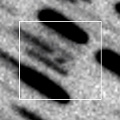
|
Now it is 18.6 mag (Mar. 13, Toshihiko Ikemura, Hirohisa Sato). It will brighten rapidly, and brighten up to 7 mag from August to September. In the Northern Hemisphere, it will be observable in excellent condition. In the Southern Hemisphere, it will be unobservable from July to August. But it will be observable in good condition before and after tha.
Date(TT) R.A. (2000) Decl. Delta r Elong. m1 Best Time(A, h)
Apr. 7 19 5.21 9 58.7 1.976 2.185 88 16.5 4:12 (307, 54)
Apr. 14 19 15.86 12 13.4 1.854 2.123 90 16.1 4:01 (307, 57)
|
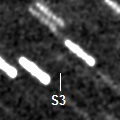
|
It is expected to approach to Sun down to 0.2 a.u. and brighten up to 3 mag in August. Now it is 17.5 mag (Mar. 24, D. Buczynski). In the Northern Hemisphere, it stays observable in the morning sky until early August when the comet brightens up to 6 mag. It is not observable at all in the Southern Hemisphere.
Date(TT) R.A. (2000) Decl. Delta r Elong. m1 Best Time(A, h)
Apr. 7 23 1.59 52 31.3 3.139 2.645 52 16.7 4:12 (224, 29)
Apr. 14 23 15.97 52 59.0 3.049 2.544 51 16.5 4:01 (223, 29)
|

|
Now it is 16.2 mag (Mar. 12, Toshihiko Ikemura, Hirohisa Sato). It will be fading slowly after this.
Date(TT) R.A. (2000) Decl. Delta r Elong. m1 Best Time(A, h)
Apr. 7 10 18.21 8 8.6 8.876 9.627 136 16.5 21:16 ( 0, 63)
Apr. 14 10 17.64 8 23.9 8.963 9.632 129 16.6 20:48 ( 0, 63)
|
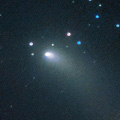
|
It brightened up to 9-10 mag from December to February. Now it is fading very rapidly. It has already faded down to 16.1 mag (Mar. 28, Martin Masek). In the Northern Hemisphere, it stays extremely low after this. In the Southern Hemisphere, it will be getting higher in the morning sky after this, then it stays observable in good condition.
Date(TT) R.A. (2000) Decl. Delta r Elong. m1 Best Time(A, h)
Apr. 7 21 59.25 -15 3.8 1.417 1.094 50 16.7 4:12 (293, 6)
Apr. 14 22 5.68 -19 59.3 1.393 1.206 57 17.1 4:01 (298, 5)
|

|
It brightened up to 8.1 mag in autumn (Oct. 3, Juan Jose Gonzalez). Now it is fading rapidly. It has already faded down to 17.9 mag (Mar. 11, Toshihiko Ikemura, Hirohisa Sato). In the Northern Hemisphere, it stays observable in good condition for a long time. In the Southern Hemisphere, it will never be observable again after this.
Date(TT) R.A. (2000) Decl. Delta r Elong. m1 Best Time(A, h)
Apr. 7 8 0.98 63 25.7 2.527 2.727 90 16.8 19:52 (168, 61)
Apr. 14 8 14.68 61 17.8 2.655 2.796 87 17.1 19:59 (162, 61)
|
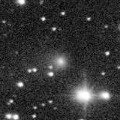
|
Now it is 16.4 mag (Mar. 14, Toshihiko Ikemura, Hirohisa Sato). It will be fading after this. In the Northern Hemisphere, it stays observable in the northern sky for a long time. It is not observable at all after this in the Southern Hemisphere.
Date(TT) R.A. (2000) Decl. Delta r Elong. m1 Best Time(A, h)
Apr. 7 23 27.34 83 47.4 3.813 3.730 77 16.8 4:12 (187, 34)
Apr. 14 0 41.42 85 43.8 3.868 3.764 76 16.9 4:01 (185, 34)
|
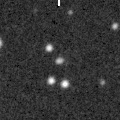
|
Now it is 16.8 mag (Apr. 5, Martin Masek). It is observable at 17 mag in good condition in spring.
Date(TT) R.A. (2000) Decl. Delta r Elong. m1 Best Time(A, h)
Apr. 7 12 56.97 -12 18.8 1.543 2.541 174 16.8 23:54 ( 0, 43)
Apr. 14 12 52.98 -11 41.8 1.542 2.537 171 16.9 23:22 ( 0, 43)
|

|
Now it is 16.8 mag (Mar. 12, Toshihiko Ikemura, Hirohisa Sato). It will brighten up to 15 mag in January, 2019. It stays observable in excellent condition in the Northern Hemispehre. It is observable only until June in the Southern Hemisphere.
Date(TT) R.A. (2000) Decl. Delta r Elong. m1 Best Time(A, h)
Apr. 7 11 32.47 29 33.5 3.385 4.182 137 16.9 22:29 ( 0, 85)
Apr. 14 11 21.59 30 52.9 3.430 4.144 129 16.9 21:51 ( 0, 86)
|

|
Now it is 16.5 mag (Mar. 12, Toshihiko Ikemura, Hirohisa Sato). It has not been brightening well since the discovery in 2010. It is observable in good conditioin in the Northern Hemisphere. It is not observable for a long time in the Southern Hemisphere.
Date(TT) R.A. (2000) Decl. Delta r Elong. m1 Best Time(A, h)
Apr. 7 6 1.24 73 7.8 8.792 8.662 79 16.9 19:52 (163, 46)
Apr. 14 6 8.68 72 46.0 8.851 8.653 75 16.9 19:59 (161, 45)
|

|
Now it is 16.7 mag (Mar. 17, Toshihiko Ikemura, Hirohisa Sato). It will be fading gradually after this, and it will be fainter than 18 mag in autumn. In the Northern Hemisphere, it stays observable in good condition for a long time. In the Southern Hemisphere, it will never be observable again.
Date(TT) R.A. (2000) Decl. Delta r Elong. m1 Best Time(A, h)
Apr. 7 22 14.11 65 17.9 7.409 7.054 65 17.0 4:12 (211, 37)
Apr. 14 22 24.22 66 1.9 7.444 7.076 64 17.0 4:01 (210, 38)
|

|
Now it is 16.8 mag (Mar. 15, iTelescope Observatory, Siding Spring). In the Southern Hemisphere, it is observable at 17 mag in good condition. It will be too low to observe in June. In the Northern Hemisphere, it locates extremely low only in spring.
Date(TT) R.A. (2000) Decl. Delta r Elong. m1 Best Time(A, h)
Apr. 7 5 25.73 -32 19.8 2.813 2.707 73 17.0 19:52 ( 42, 7)
Apr. 14 5 38.63 -29 28.5 2.849 2.706 71 17.0 19:59 ( 48, 6)
|

|
Now it is 17.3 mag (Mar. 12, Toshihiko Ikemura, Hirohisa Sato). It will be fading after this, and it will be fainter than 18 mag in July.
Date(TT) R.A. (2000) Decl. Delta r Elong. m1 Best Time(A, h)
Apr. 7 11 53.72 22 22.4 4.766 5.628 146 17.0 22:50 ( 0, 77)
Apr. 14 11 47.66 23 24.7 4.855 5.652 139 17.1 22:17 ( 0, 78)
|

|
Now it is 16.4 mag (Mar. 13, Toshihiko Ikemura, Hirohisa Sato). It will be fainter than 18 mag in summer.
Date(TT) R.A. (2000) Decl. Delta r Elong. m1 Best Time(A, h)
Apr. 7 14 57.48 -14 0.2 5.415 6.307 150 17.2 1:58 ( 0, 41)
Apr. 14 14 54.65 -13 4.9 5.381 6.324 158 17.2 1:28 ( 0, 42)
|
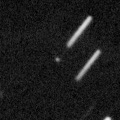
|
Now it is 17.3 mag (Mar. 22, Toshihiko Ikemura, Hirohisa Sato). It is observable at 17 mag from spring to summer.
Date(TT) R.A. (2000) Decl. Delta r Elong. m1 Best Time(A, h)
Apr. 7 15 13.61 41 43.2 1.351 2.074 123 17.3 2:14 (180, 83)
Apr. 14 15 11.89 41 39.0 1.312 2.048 123 17.2 1:45 (180, 83)
|

|
Now it is 17.7 mag (Mar. 25, D. Buczynski). It stays observable at 17-18 mag in good condition for a while.
Date(TT) R.A. (2000) Decl. Delta r Elong. m1 Best Time(A, h)
Apr. 7 15 15.66 -5 28.0 1.776 2.670 146 17.3 2:17 ( 0, 49)
Apr. 14 15 11.08 -4 58.1 1.769 2.706 154 17.4 1:44 ( 0, 50)
|
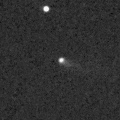
|
It brightened up to 15.7 mag in February (Feb. 11, Catalina Sky Survey). Now it is fading rapidly. It has already faded down to 16.9 mag (Mar. 24, Toshihiko Ikemura, Hirohisa Sato). It will be fainter than 18 mag in late April.
Date(TT) R.A. (2000) Decl. Delta r Elong. m1 Best Time(A, h)
Apr. 7 13 20.20 21 13.5 0.530 1.489 151 17.4 0:21 ( 0, 76)
Apr. 14 13 17.41 19 25.9 0.563 1.521 151 17.6 23:47 ( 0, 74)
|
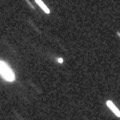
|
Now it is 17.1 mag (Mar. 12, Toshihiko Ikemura, Hirohisa Sato). It will be fading gradually after this.
Date(TT) R.A. (2000) Decl. Delta r Elong. m1 Best Time(A, h)
Apr. 7 10 53.98 39 1.9 7.598 8.220 125 17.4 21:51 (180, 86)
Apr. 14 10 49.78 38 34.8 7.697 8.240 119 17.4 21:20 (180, 87)
|

|
It brightened up to 9.7 mag in November (Nov. 16, Juan Jose Gonzalez). Now it is fading rapidly. It has already faded down to 16.6 mag (Mar. 22, W. Hasubick).
Date(TT) R.A. (2000) Decl. Delta r Elong. m1 Best Time(A, h)
Apr. 7 16 49.66 -13 3.5 1.347 2.077 123 17.4 3:50 ( 0, 42)
Apr. 14 16 45.96 -13 14.2 1.336 2.136 131 17.7 3:19 ( 0, 42)
|
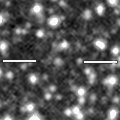
|
Now it is 18.4 mag (Mar. 17, Toshihiko Ikemura, Hirohisa Sato). It stays observable at 17 mag in good condition from spring to autumn.
Date(TT) R.A. (2000) Decl. Delta r Elong. m1 Best Time(A, h)
Apr. 7 20 42.79 -2 40.5 6.350 6.003 65 17.5 4:12 (296, 28)
Apr. 14 20 46.63 -2 9.2 6.251 6.000 70 17.4 4:01 (298, 31)
|

|
Now it is 19.7 mag (Mar. 24, Toshihiko Ikemura, Hirohisa Sato). It was predicted to be observable at 17.5 mag in good condition from spring to summer. But recently, it is fainter than predicted.
Date(TT) R.A. (2000) Decl. Delta r Elong. m1 Best Time(A, h)
Apr. 7 16 37.79 -8 41.4 3.204 3.884 126 17.8 3:38 ( 0, 46)
Apr. 14 16 36.85 -8 29.7 3.126 3.883 133 17.8 3:10 ( 0, 46)
|
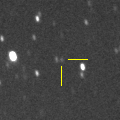
|
Now it is 17.9 mag (Mar. 16, ATLAS-HKO, Haleakala). It stays 18 mag from 2018 to 2020. It is observable in good condition in the Southern Hemisphere. It locates extremely low in the Northern Hemisphere.
Date(TT) R.A. (2000) Decl. Delta r Elong. m1 Best Time(A, h)
Apr. 7 12 42.22 -38 17.8 3.647 4.527 148 17.9 23:39 ( 0, 17)
Apr. 14 12 36.99 -38 9.3 3.634 4.522 148 17.9 23:06 ( 0, 17)
|
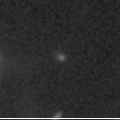
|
Now it is 17.2 mag (Mar. 22, Kunihiro Shima). It is observable at 18 mag in good condition in spring.
Date(TT) R.A. (2000) Decl. Delta r Elong. m1 Best Time(A, h)
Apr. 7 12 29.36 -3 19.1 1.258 2.253 171 17.9 23:26 ( 0, 52)
Apr. 14 12 25.37 -2 10.2 1.254 2.232 162 17.9 22:55 ( 0, 53)
|

|
It has passed the perihelion on Jan. 23, and it approached to the Sun down to 0.1 a.u. It was observed at 19.1 mag in good condition in March (Mar. 24, Steward Observatory, Mt. Lemmon Station). It is observable at 19.5 mag in good condition in March. It will fade out rapidly after this.
Date(TT) R.A. (2000) Decl. Delta r Elong. m1 Best Time(A, h)
Apr. 7 12 3.40 -4 12.8 0.666 1.653 165 20.5 22:59 ( 0, 51)
Apr. 14 11 46.18 -1 39.6 0.795 1.751 153 21.2 22:15 ( 0, 53)
|
|
![]()
 29P/Schwassmann-Wachmann 1
29P/Schwassmann-Wachmann 1 C/2017 T3 ( ATLAS )
C/2017 T3 ( ATLAS ) 37P/Forbes
37P/Forbes 185P/Petriew
185P/Petriew C/2015 V2 ( Johnson )
C/2015 V2 ( Johnson ) 62P/Tsuchinshan 1
62P/Tsuchinshan 1 48P/Johnson
48P/Johnson C/2017 K6 ( Jacques )
C/2017 K6 ( Jacques ) C/2017 M4 ( ATLAS )
C/2017 M4 ( ATLAS ) C/2017 B3 ( LINEAR )
C/2017 B3 ( LINEAR ) 65P/Gunn
65P/Gunn C/2016 A1 ( PanSTARRS )
C/2016 A1 ( PanSTARRS ) C/2015 VL62 ( Lemmon-Yeung-PanSTARRS )
C/2015 VL62 ( Lemmon-Yeung-PanSTARRS ) 74P/Smirnova-Chernykh
74P/Smirnova-Chernykh (3552) Don Quixote
(3552) Don Quixote 21P/Giacobini-Zinner
21P/Giacobini-Zinner C/2017 S3 ( PanSTARRS )
C/2017 S3 ( PanSTARRS ) C/2014 B1 ( Schwartz )
C/2014 B1 ( Schwartz ) C/2017 T1 ( Heinze )
C/2017 T1 ( Heinze ) C/2017 O1 ( ASASSN )
C/2017 O1 ( ASASSN ) C/2016 N4 ( MASTER )
C/2016 N4 ( MASTER ) 143P/Kowal-Mrkos
143P/Kowal-Mrkos C/2018 A3 ( ATLAS )
C/2018 A3 ( ATLAS ) C/2010 U3 ( Boattini )
C/2010 U3 ( Boattini ) C/2014 OE4 ( PanSTARRS )
C/2014 OE4 ( PanSTARRS ) C/2018 E1 ( ATLAS )
C/2018 E1 ( ATLAS ) C/2017 D3 ( ATLAS )
C/2017 D3 ( ATLAS ) C/2017 E3 ( PanSTARRS )
C/2017 E3 ( PanSTARRS ) C/2018 C2 ( Lemmon )
C/2018 C2 ( Lemmon ) 30P/Reinmuth 1
30P/Reinmuth 1 365P/2017 U6 ( PanSTARRS )
365P/2017 U6 ( PanSTARRS ) C/2014 R3 ( PanSTARRS )
C/2014 R3 ( PanSTARRS ) 24P/Schaumasse
24P/Schaumasse C/2017 M5 ( TOTAS )
C/2017 M5 ( TOTAS ) 187P/LINEAR
187P/LINEAR 186P/Garradd
186P/Garradd 105P/Singer Brewster
105P/Singer Brewster 2011 KE
2011 KE![]()






































